Accardi L., Freudenberg W., Obya M. (Eds.) Quantum Bio-informatics IV: From Quantum Information to Bio-informatics
Подождите немного. Документ загружается.

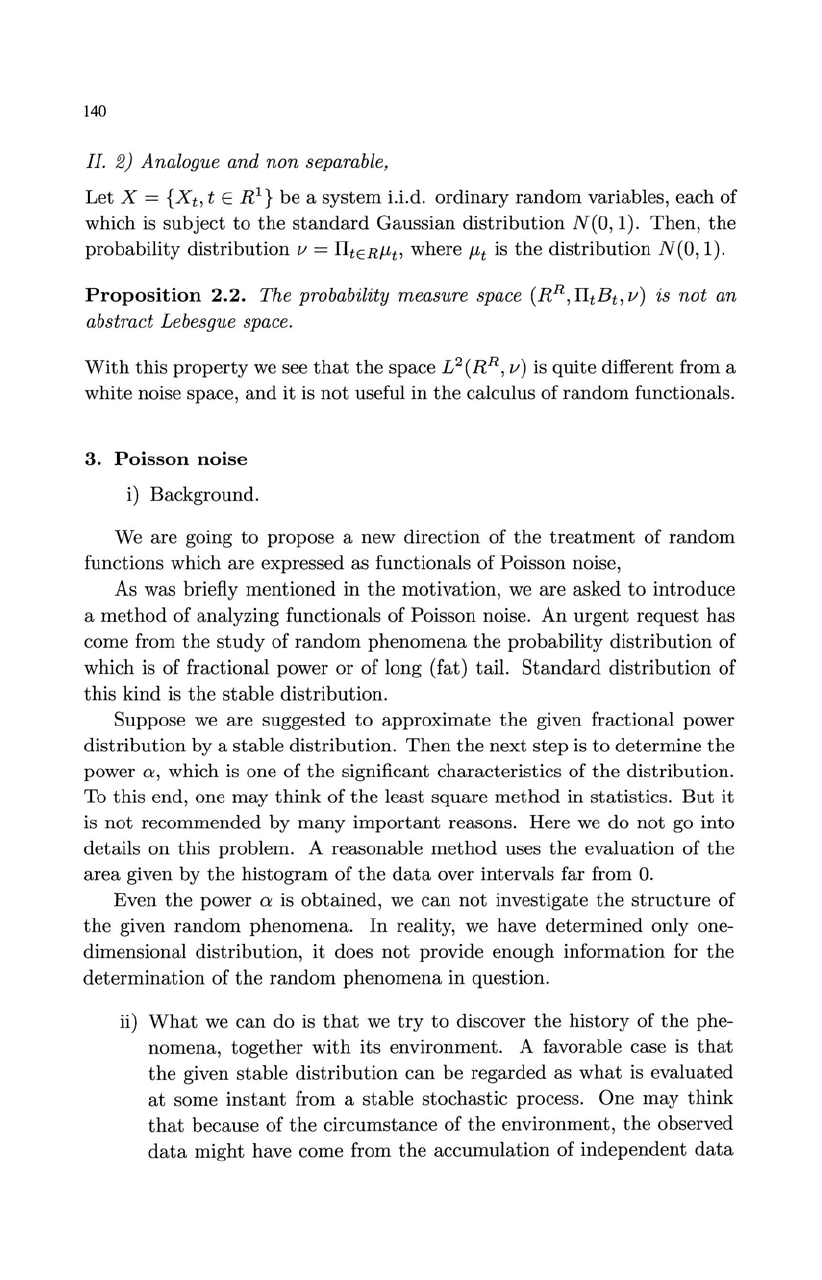
140
II.
2) Analogue and
non
separable,
Let
X =
{Xt,
t E
Rl}
be
a
system
i.i.d.
ordinary
random
variables, each of
which is
subject
to
the
standard
Gaussian
distribution
N(O, 1).
Then,
the
probability
distribution
v = IItERlLt, where
ILt
is
the
distribution
N(O,
1).
Proposition
2.2.
The probability measure space (RR,
IItB
t
,
v)
is
not
an
abstract Lebesgue space.
With
this
property
we
see
that
the
space L2(RR,
v)
is
quite
different from a
white
noise space,
and
it
is
not
useful
in
the
calculus
of
random
functionals.
3.
Poisson
noise
i) Background.
We
are
going
to
propose a new direction
of
the
treatment
of
random
functions which
are
expressed as functionals
of
Poisson noise,
As was briefly mentioned
in
the
motivation,
we
are
asked
to
introduce
a
method
of
analyzing functionals of Poisson noise.
An
urgent
request
has
come from
the
study
of
random
phenomena
the
probability
distribution
of
which is of fractional power
or
of
long (fat) tail.
Standard
distribution
of
this
kind is
the
stable
distribution.
Suppose
we
are
suggested
to
approximate
the
given fractional power
distribution
by a
stable
distribution.
Th
en
the
next
step
is
to
determine
the
power
CY,
which is one of
the
significant characteristics of
the
distribution.
To
this
end, one
may
think
of
the
least
square
method
in statistics.
But
it
is
not
recommended by
many
important
reasons. Here we do
not
go into
details
on
this
problem. A reasonable
method
uses
the
evaluation
of
the
area
given by
the
histogram
of
the
data
over intervals far from
O.
Even
the
power
CY
is
obtained,
we
can
not
investigate
the
structure
of
the
given
random
phenomena
.
In
reality,
we
have d
ete
rmined
only one-
dimensional distribution,
it
does
not
provide enough information for
the
determination
of
the
random
phenomena
in
question.
ii)
Wh
at
we
can
do is
that
we
try
to
discover
the
history
of
the
phe-
nomena,
together
with
its
environment. A favorable case is
that
the
given
stable
distribution
can
be
regarded as
what
is evaluated
at
some
instant
from a
stable
stochastic process.
One
may
think
that
because
of
the
circumstance
of
the
environment,
the
observed
data
might
have come from
the
accumulation
of
independent
data
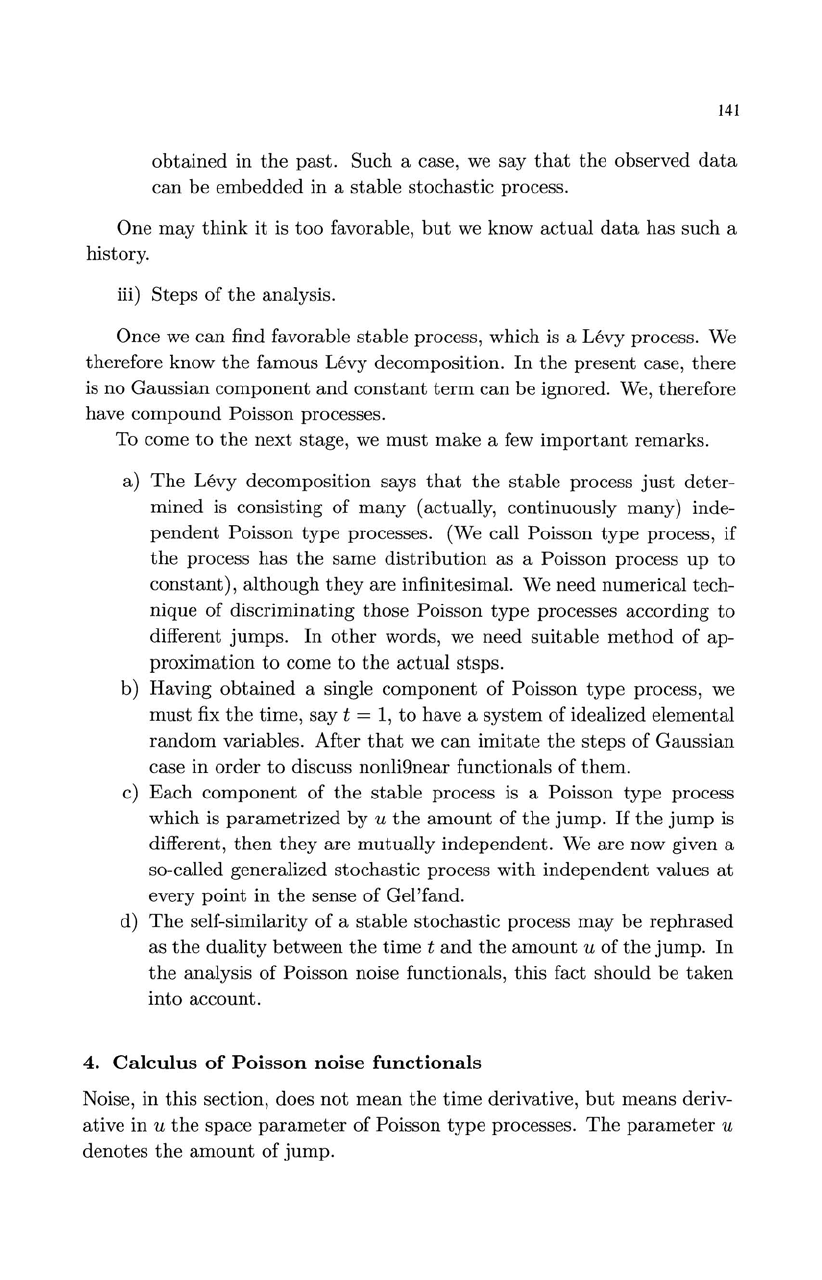
141
obtained
in
the
past.
Such a case, we say
that
the
observed
data
can
be
embedded
in
a
stable
stochastic
process.
One
may
think
it
is
too
favorable,
but
we know
actual
data
has such a
history.
iii)
Steps
of the
analysis.
Once we
can
find favorable
stable
process, which is a Levy process. We
therefore know
the
famous Levy decomposition. In
the
present case,
there
is
no
Gaussian
component
and
constant
term
can
be
ignored. We, therefore
have
compound
Poisson processes.
To come
to
the
next
stage, we
must
make
a few
important
remarks.
a)
The
Levy decomposition says
that
the
stable
process
just
deter-
mined
is consisting of
many
(actually, continuously
many)
inde-
pendent
Poisson
type
processes. (We call Poisson
type
process,
if
the
process
has
the
same
distribution
as
a Poisson process
up
to
constant),
although
they
are
infinitesimal. We need numerical tech-
nique
of
discriminating
those
Poisson
type
processes according
to
different
jumps.
In
other
words, we need
suitable
method
of
ap-
proximation
to
come
to
the
actual
stsps.
b) Having
obtained
a single
component
of
Poisson
type
process,
we
must
fix
the
time,
say
t = 1,
to
have a
system
of
idealized elemental
random
variables. After
that
we
can
imitate
the
steps
of
Gaussian
case
in
order
to
discuss nonli9near functionals
of
them.
c)
Each
component
of
the
stable
process is a Poisson
type
process
which is
parametrized
by
u
the
amount
of
the
jump.
If
the
jump
is
different,
then
they
are
mutually
independent.
We
are
now given a
so-called generalized
stochastic
process
with
independent
values
at
every
point
in
the
sense
of
Gel'fand.
d)
The
self-similarity
of
a
stable
stochastic
process
may
be
rephrased
as
the
duality
between
the
time
t
and
the
amount
u of
the
jump.
In
the
analysis
of
Poisson noise functionals,
this
fact
should
be
taken
into
account.
4.
Calculus
of
Poisson
noise
functionals
Noise, in
this
section, does
not
mean
the
time
derivative,
but
means
deriv-
ative in u
the
space
parameter
of
Poisson
type
processes.
The
parameter
u
denotes
the
amount
of
jump.
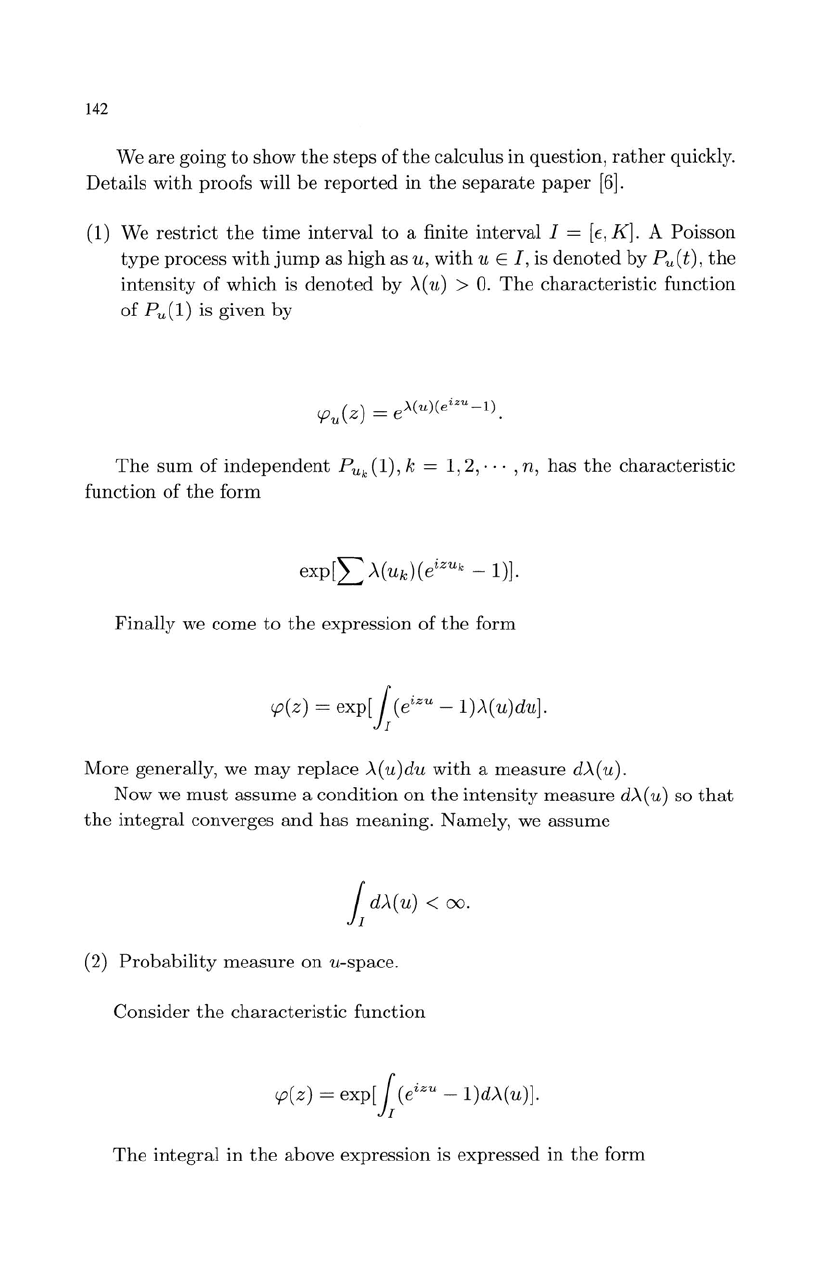
142
We
are
going
to
show
the
steps
of
the
calculus
in
question,
rather
quickly.
Details
with
proofs will
be
reported
in
the
separate
paper
[6].
(1) We
restrict
the
time
interval
to
a finite
interval
I =
[E,
K]. A Poisson
type
process
with
jump
as high
as
u,
with
u E I, is
denoted
by
Pu(t),
the
intensity
of
which is
denoted
by
>.(u)
>
O.
The
characteristic
function
of P
u
(1)
is given
by
The
sum
of
independent
P
Uk
(1), k =
1,2""
,n,
has
the
characteristic
function
of the
form
Finally
we
come
to
the
expression
of
the
form
cp(z)
=
exp[j
(e
izu
- l)>.(u)du].
More generally, we
may
replace
>.(u)du
with
a
measure
d>.(u).
Now we
must
assume
a
condition
on
the
intensity
measure
d>.(u)
so
that
the
integral
converges
and
has
meaning. Namely, we
assume
j
d>.(u)
<
00.
(2)
Probability
measure
on
u-space.
Consider
the
characteristic
function
cp(z)
=
exp[j
(e
izu
- l)d>.(u)].
The
integral
in
the
above expression is expressed
in
the
form
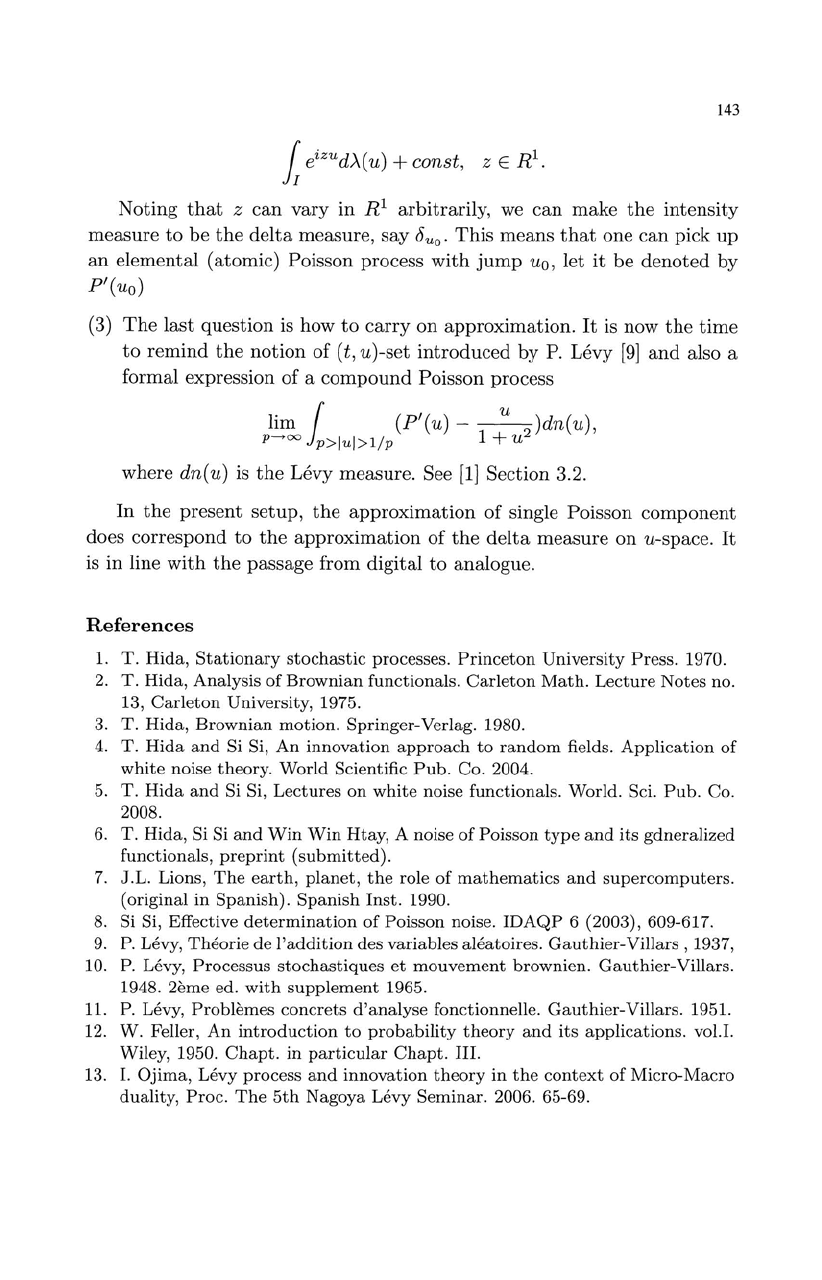
143
1
eiZUd)"(u)
+ canst, Z E
RI.
Noting
that
Z
can
vary
in
RI
arbitrarily,
we
can
make
the
intensity
measure
to
be
the
delta
measure, say
bUD.
This
means
that
one
can
pick
up
an
elemental (atomic) Poisson process
with
jump
uo,
let
it
be
denoted
by
F'(uo)
(3)
The
last
question is how
to
carryon
approximation.
It
is now
the
time
to
remind
the
notion
of
(t,
u)-set
introduced
by
P. Levy
[9]
and
also a
formal expression
of
a
compound
Poisson process
lim
1
(F'(u)
-
~
)dn(u),
p->oo
p>lul>l/p
1 + u
where dn(u) is
the
Levy measure. See
[1]
Section 3.2.
In
the
present
setup,
the
approximation
of
single Poisson
component
does
correspond
to
the
approximation
of
the
delta
measure
on
u-space.
It
is
in
line
with
the
passage from digital
to
analogue.
References
1.
T.
Hida,
Stationary
stochastic
processes.
Princeton
University
Press. 1970.
2.
T.
Hida,
Analysis
of
Brownian
functionals.
Carleton
Math.
Lecture
Notes
no.
13,
Carleton
University, 1975.
3.
T.
Hida,
Brownian
motion.
Springer-Verlag. 1980.
4.
T.
Hida
and
Si Si,
An
innovation
approach
to
random
fields.
Application
of
white
noise theory.
World
Scientific
Pub.
Co. 2004.
5.
T.
Hida
and
Si Si,
Lectures
on
white
noise functionals. World. Sci.
Pub.
Co.
2008.
6.
T.
Hida,
Si Si
and
Win
Win
Htay, A noise
of
Poisson
type
and
its
gdneralized
functionals,
preprint
(submitted).
7.
J.L.
Lions,
The
earth,
planet,
the
role
of
mathematics
and
supercomputers.
(original in
Spanish).
Spanish
Inst.
1990.
8. Si Si, Effective
determination
of
Poisson
noise.
IDAQP
6 (2003), 609-617.
9.
P. Levy,
Theorie
de
l'addition
des
variables
aleatoires.
Gauthier-Villars,
1937,
10. P. Levy,
Processus
stochastiques
et
mouvement
brownien.
Gauthier-Villars.
1948. 2eme ed.
with
supplement
1965.
11. P.
Levy,
Problemes
concrets
d'analyse
fonctionnelle.
Gauthier-Villars.
1951.
12.
W.
Feller,
An
introduction
to
probability
theory
and
its
applications.
vol.1.
Wiley, 1950.
Chapt.
in
particular
Chapt.
III.
13. I.
Ojima,
Levy
process
and
innovation
theory
in
the
context
of
Micro-Macro
duality,
Proc.
The
5th
Nagoya
Levy
Seminar.
2006. 65-69.

This page intentionally left blankThis page intentionally left blank
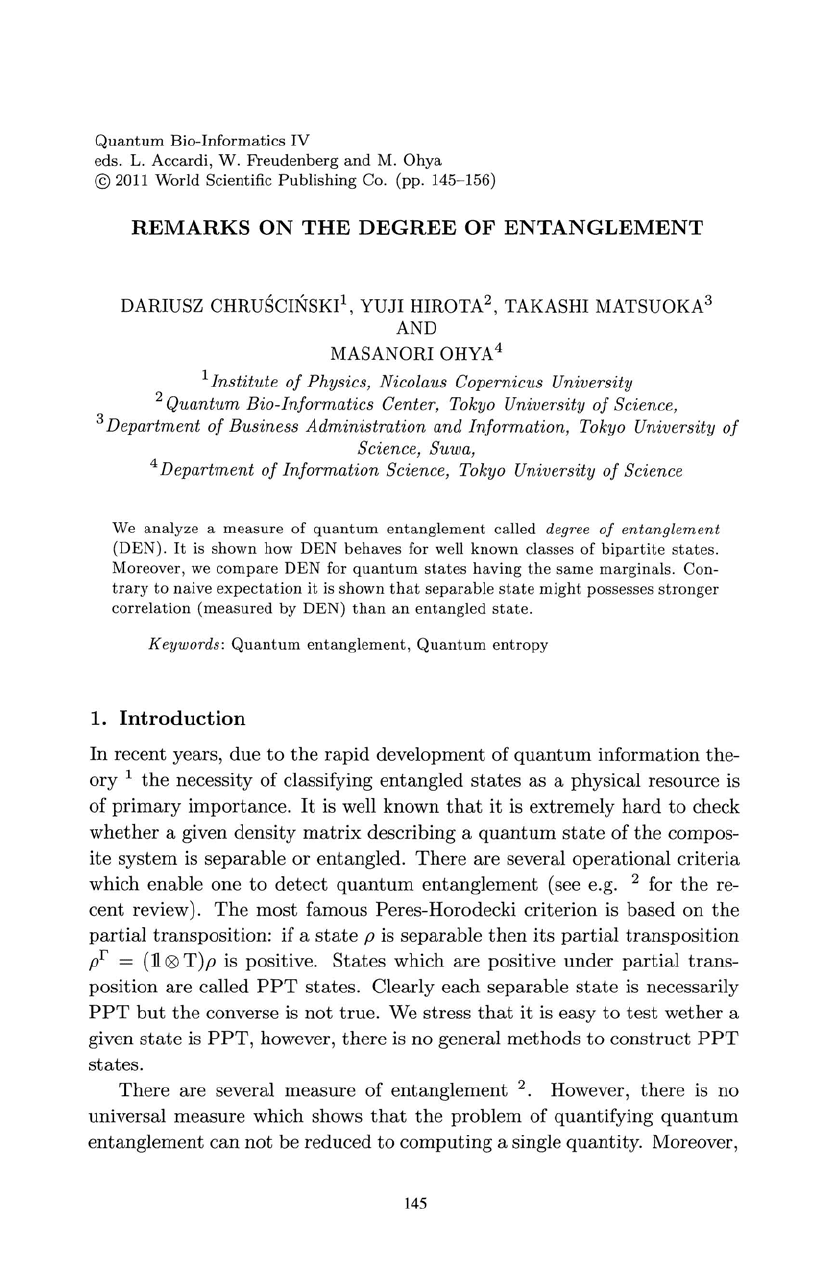
Quantum
Bio-Informatics
IV
eds. L.
Accardi,
W.
Freudenberg
and
M.
Ohya
© 2011
World
Scientific
Publishing
Co.
(pp.
145-156)
REMARKS
ON
THE
DEGREE
OF
ENTANGLEMENT
DARIUSZ CHRUSCINSKIl,
YUJI
HIROTA
2
,
TAKASHI MATSUOKA
3
AND
MASANORI OHYA
4
1
Institute
of
Physics, Nicolaus Copernicus University
2
Quantum
Bio-Informatics Center, Tokyo University
of
Science,
3 Department
of
Business
Administration
and Information, Tokyo University
of
Science, Suwa,
4 Department
of
Information
Science, Tokyo University
of
Science
We
analyze
a
measure
of
quantum
entanglement
called
degree
of
entanglement
(DEN).
It
is
shown
how
DEN
behaves
for well
known
classes
of
bipartite
states.
Moreover,
we
compare
DEN
for
quantum
states
having
the
same
marginals.
Con-
trary
to
naive
expectation
it
is
shown
that
separable
state
might
possesses
stronger
correlation
(measured
by
DEN)
than
an
entangled
state.
Keywords:
Quantum
entanglement,
Quantum
entropy
1.
Introduction
In
recent years,
due
to
the
rapid
development of
quantum
information
the-
ory
1
the
necessity of classifying
entangled
states
as
a physical resource is
of
primary
importance.
It
is well known
that
it
is
extremely
hard
to
check
whether
a given
density
matrix
describing a
quantum
state
of
the
compos-
ite
system
is
separable
or
entangled.
There
are
several
operational
criteria
which
enable
one
to
detect
quantum
entanglement
(see e.g. 2 for
the
re-
cent
review).
The
most
famous Peres-Horodecki
criterion
is
based
on
the
partial
transposition:
if
a
state
p is
separable
then
its
partial
transposition
pr
= (ll ®
T)p
is positive.
States
which
are
positive
under
partial
trans-
position
are
called
PPT
states.
Clearly
each
separable
state
is necessarily
PPT
but
the
converse is
not
true.
We
stress
that
it
is easy
to
test
wether
a
given
state
is
PPT,
however,
there
is
no
general
methods
to
construct
PPT
states.
There
are
several
measure
of
entanglement
2.
However,
there
is
no
universal
measure
which shows
that
the
problem
of
quantifying
quantum
entanglement
can
not
be
reduced
to
computing
a single
quantity.
Moreover,
145
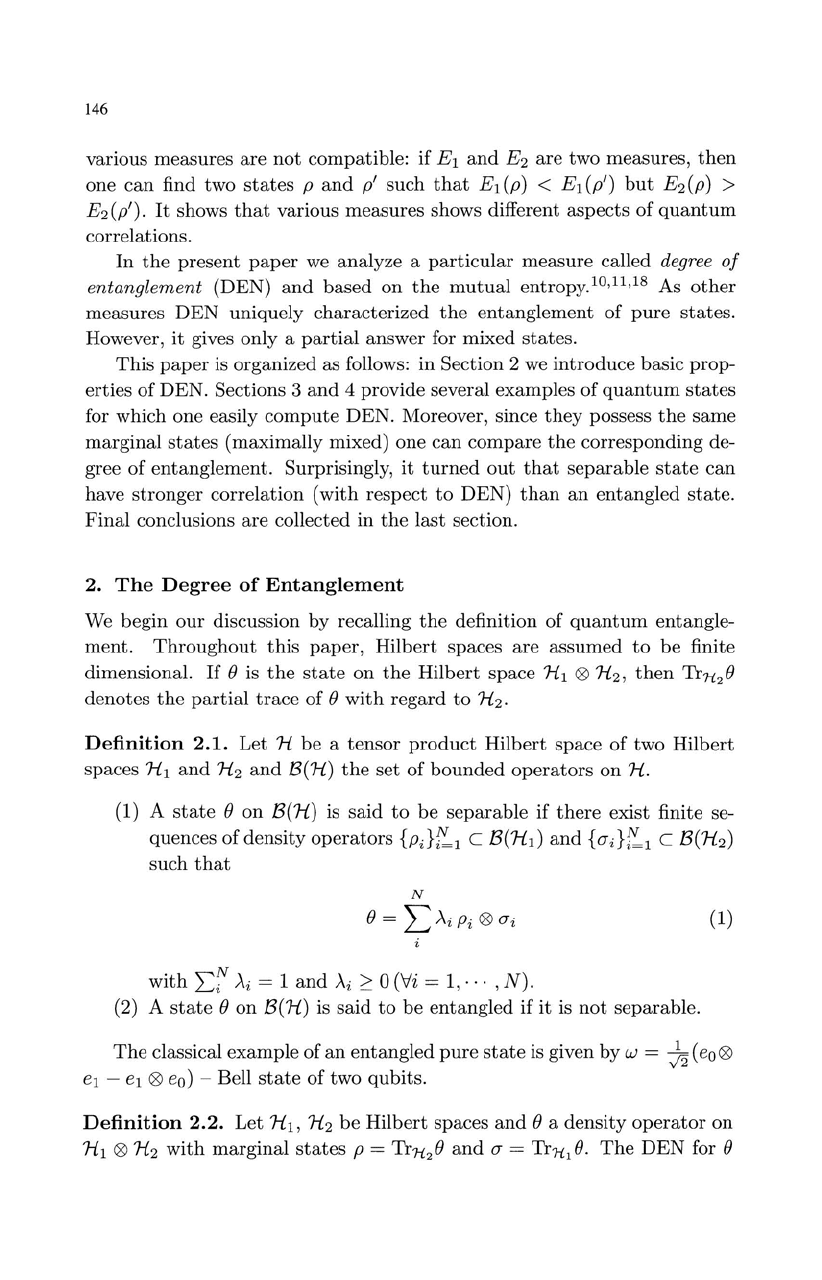
146
various
measures
are
not
compatible:
if
EI
and
E2
are
two measures,
then
one
can
find two
states
p
and
pi such
that
EI
(p) <
EI
(pi)
but
E2 (p) >
E2(p').
It
shows
that
various
measures
shows different
aspects
of
quantum
correlations.
In
the
present
paper
we
analyze
a
particular
measure
called degree
of
entanglement
(DEN)
and
based
on
the
mutual
entropy.1O,1l,18 As
other
measures
DEN
uniquely
characterized
the
entanglement
of
pure
states.
However,
it
gives
only
a
partial
answer for
mixed
states.
This
paper
is
organized
as
follows:
in
Section 2 we
introduce
basic prop-
erties
of
DEN.
Sections 3
and
4 provide several
examples
of
quantum
states
for which one easily
compute
DEN.
Moreover, since
they
possess
the
same
marginal
states
(maximally
mixed) one
can
compare
the
corresponding
de-
gree of
entanglement.
Surprisingly,
it
turned
out
that
separable
state
can
have
stronger
correlation
(with
respect
to
DEN)
than
an
entangled
state.
Final
conclusions
are
collected in
the
last
section.
2.
The
Degree
of
Entanglement
We
begin
our
discussion
by
recalling
the
definition of
quantum
entangle-
ment.
Throughout
this
paper,
Hilbert
spaces
are
assumed
to
be
finite
dimensional.
If
e is
the
state
on
the
Hilbert
space
HI
® H
2
,
then
Tr1i2e
denotes
the
partial
trace
of
e
with
regard
to
H
2
.
Definition
2.1.
Let
H
be
a
tensor
product
Hilbert
space
of
two
Hilbert
spaces
HI
and
H2
and
B(H)
the
set
of
bounded
operators
on
H.
(1)
A
state
e
on
B(H) is
said
to
be
separable
if
there
exist
finite se-
quences
of
density
operators
{pJt'-,1 C
B(Hd
and
{O'dt'-,l
C B(H
2
)
such
that
(1)
with
"\,,N
A = 1
and
A > 0
(Vi
= 1
...
N)
~2
2
1,
-
".
(2)
A
state
e
on
B(H) is
said
to
be
entangled
if
it
is
not
separable.
The
classical
example
of
an
entangled
pure
state
is given
by
w =
Jz
(eo ®
el
-
el
® eo) - Bell
state
of
two
qubits.
Definition
2.2.
Let
HI,
H2
be
Hilbert
spaces
and
e a
density
operator
on
HI
®
H2
with
marginal
states
p = Tr1i2e
and
0'
= Tr1il
e.
The
DEN
for e
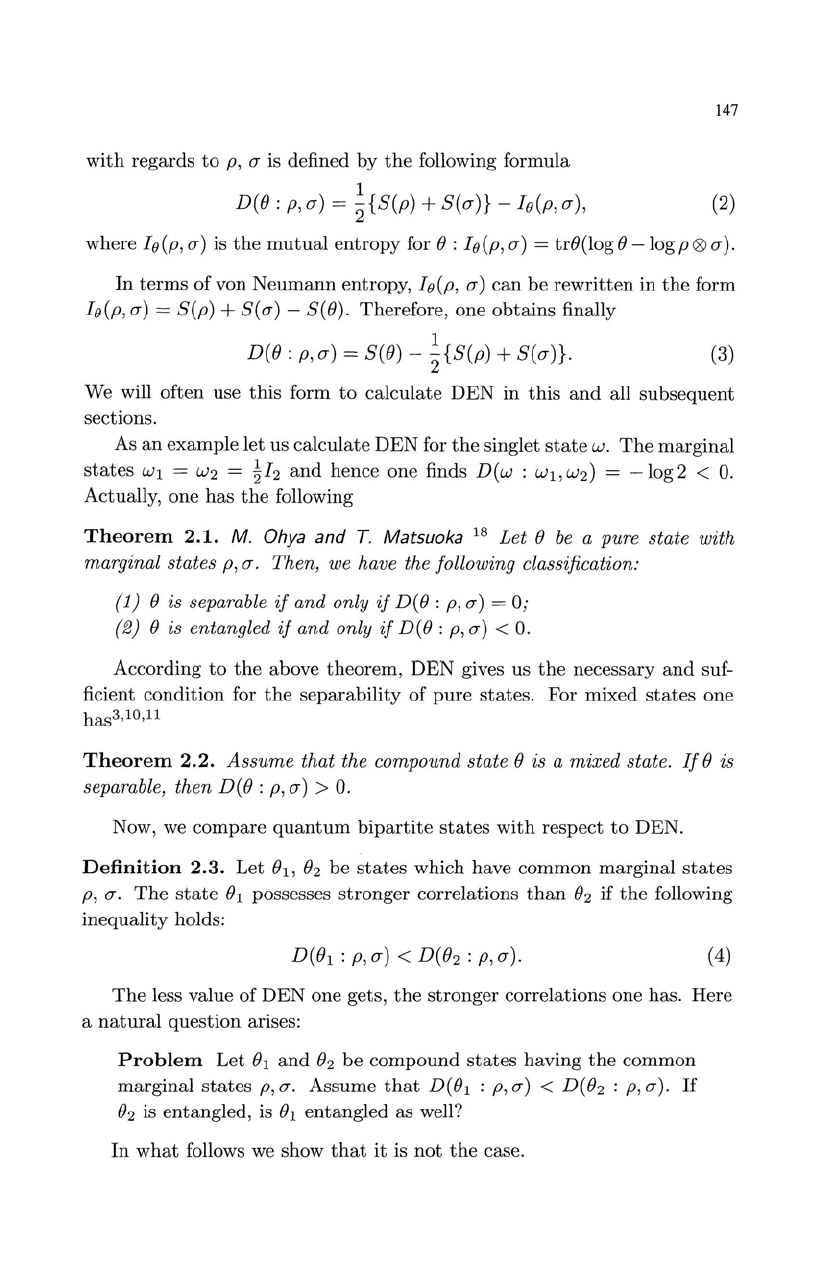
with
regards
to
p,
a is defined
by
the
following formula
1
D(()
:
p,
a) = 2{S(P) +
S(a)}
- Ie(p, a),
147
(2)
where
Ie
(p,
a) is
the
mutual
entropy
for
()
: Ie(p, a) = tr()(log
()
-log
p
(>9
a).
In
terms
of
von
Neumann
entropy,
Ie
(p,
a)
can
be
rewritten
in
the
form
Ie(p,a) = S(p) +
S(a)
- S(()). Therefore, one
obtains
finally
1
D(()
:
p,
a) = S(()) - 2{S(P) + S(a)}.
(3)
We will often use
this
form
to
calculate
DEN
in
this
and
all
subsequent
sections.
As
an
example
let us calculate
DEN
for
the
singlet
state
w.
The
marginal
states
WI
=
W2
=
~h
and
hence
one
finds D(w :
Wl,W2)
=
-log2
<
O.
Actually,
one
has
the
following
Theorem
2.1.
M.
Ohya and
T.
Matsuoka
18
Let
()
be
a pure state with
marginal states
p,
a.
Then, we have the following classification:
(1)
()
is separable
if
and only
if
D(() :
p,
a)
= 0;
(2)
()
is entangled
if
and only
if
D(() :
p,
a)
<
O.
According
to
the
above
theorem,
DEN
gives us
the
necessary
and
suf-
ficient
condition
for
the
separability
of
pure
states.
For mixed
states
one
has
3
,
10,1l
Theorem
2.2.
Assume
that
the compound state
()
is a
mixed
state.
If
()
is
separable, then D(() :
p,
a)
>
O.
Now, we
compare
quantum
bipartite
states
with
respect
to
DEN.
Definition
2.3.
Let
()1, ()2
be
states
which have
common
marginal
states
p, a.
The
state
()1
possesses
stronger
correlations
than
()2
if
the
following
inequality
holds:
D(()l : p,a) <
D(()2
: p,a). (4)
The
less value
of
DEN
one gets,
the
stronger
correlations
one
has. Here
a
natural
question arises:
Problem
Let
()1
and
()2
be
compound
states
having
the
common
marginal
states
p,
a. Assume
that
D(()l :
p,
a) <
D(()2
:
p,
a).
If
()2 is entangled, is
()1
entangled
as well?
In
what
follows we show
that
it
is
not
the
case.
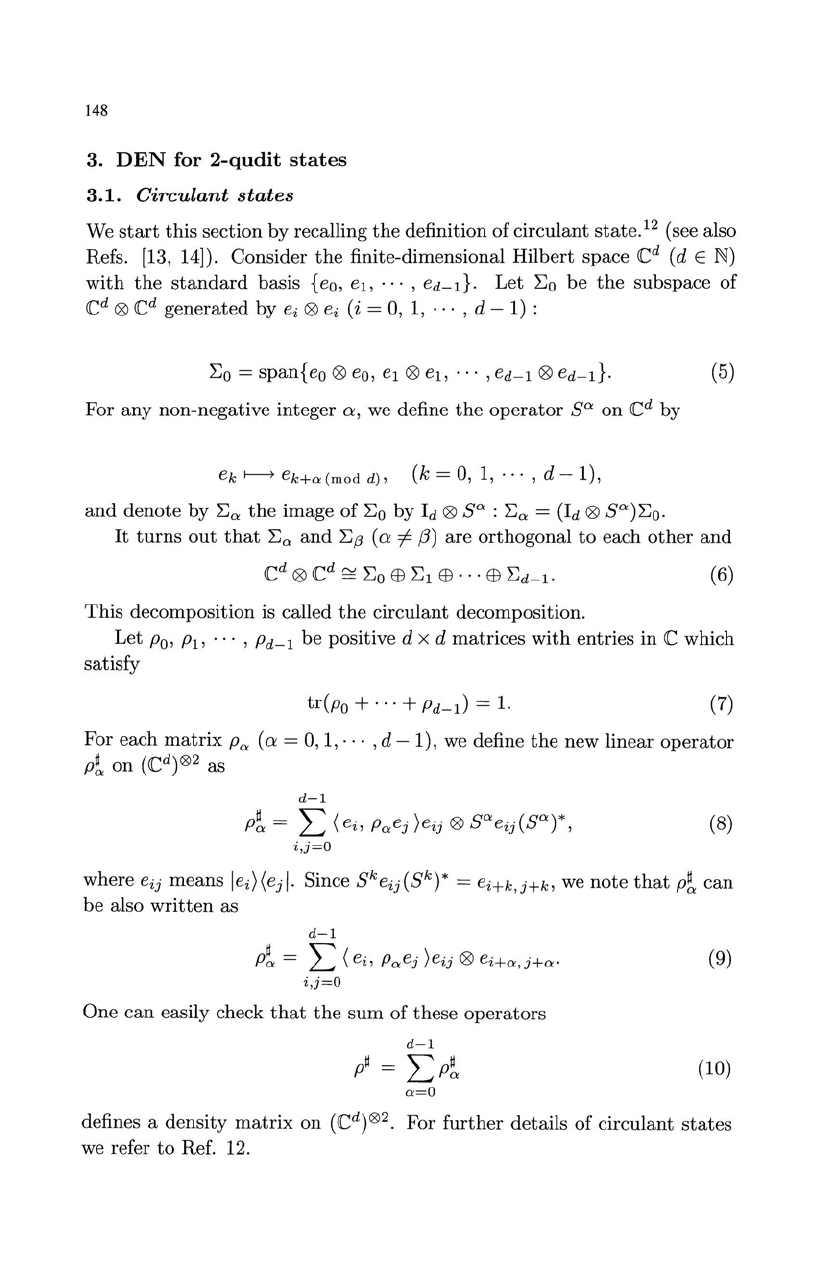
148
3.
DEN
for
2-qudit
states
3.1.
Circulant
states
We
start
this
section
by
recalling
the
definition of
circulant
state.
12
(see also
Refs.
[13,
14]).
Consider
the
finite-dimensional
Hilbert
space
Cd
(d
E N)
with
the
standard
basis {eo,
el,
...
,ed-d.
Let
~o
be
the
subspace
of
Cd 0 Cd
generated
by
ei 0 ei (i =
0,
1,
...
, d - 1) :
~o
=
span{
eo
0 eo,
el
0
el,
...
,ed-l
0
ed-I}.
(5)
For
any
non-negative
integer
0:,
we define
the
operator
sa
on
Cd by
ek
f---+
ek+a(mod
d),
(k
=
0,1,
...
, d
-1),
and
denote
by
~a
the
image
of
~o
by
Id
0
sa
:
~a
=
(Id
0
sa)~o.
It
turns
out
that
~a
and
~;3
(0:
=I-
{3)
are
orthogonal
to
each
other
and
Cd 0 Cd
~
~o
EB
~l
EB
...
EB
~d-l.
(6)
This
decomposition
is called
the
circulant
decomposition.
Let
Po,
PI'
...
,
Pd-l
be
positive d x d
matrices
with
entries
in
C which
satisfy
tr(po + ... +
Pd-l)
=
1.
(7)
For
each
matrix
Pa
(0:
=
0,1,···
,d
- 1), we define
the
new
linear
operator
p~
on
(C
d
)®2
as
d-l
p~
= L
(ei'
Paej
leij
0
sa
eij
(S")*,
(8)
i,j=O
where eij
means
leil(ejl.
Since
Skeij(Sk)*
= ei+k,j+k, we
note
that
p~
can
be
also
written
as
d-l
p~
= L
(ei'
p"ej
leij
0
eHa,j+a·
i,j=O
One
can
easily check
that
the
sum
of
these
operators
d-l
p"
=
LP~
,,=0
(9)
(10)
defines a
density
matrix
on
(C
d
)®2.
For
further
details
of
circulant
states
we refer
to
Ref. 12.
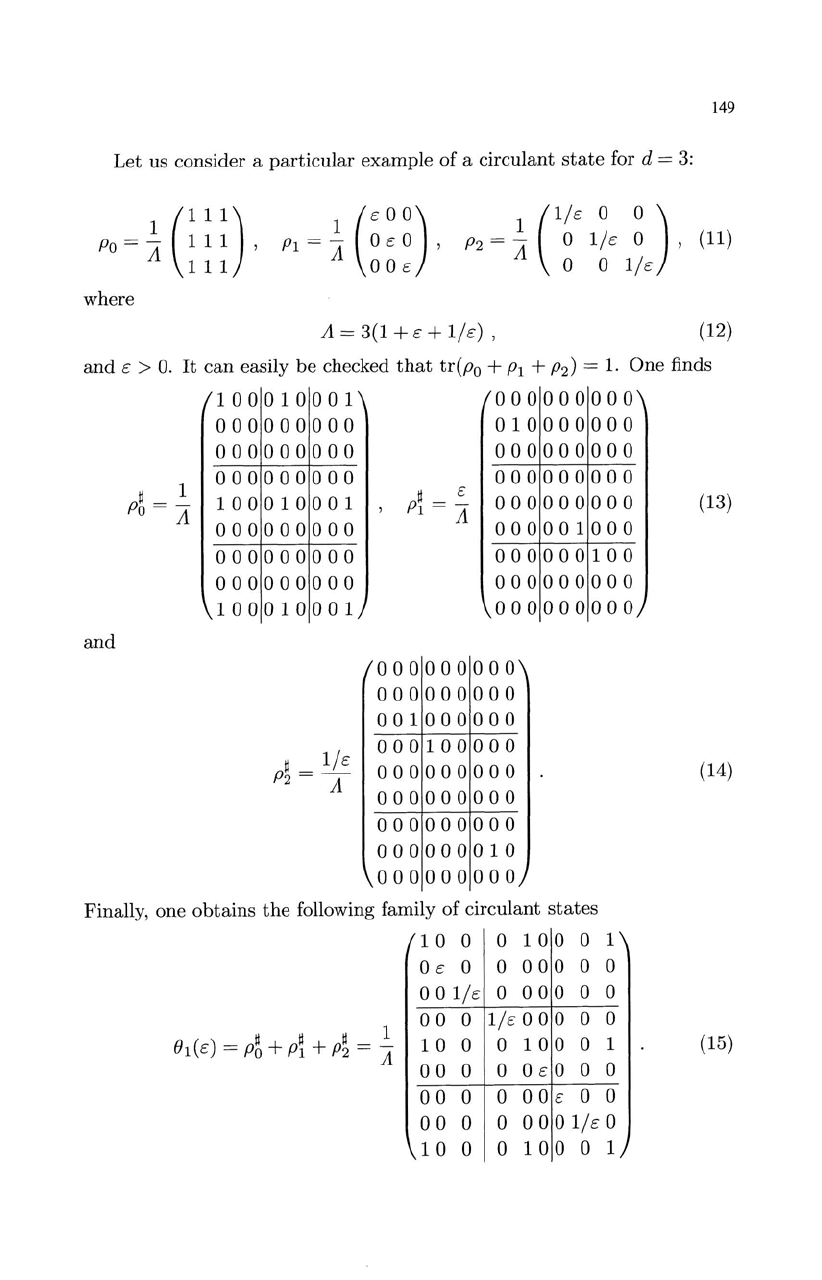
149
Let
us consider a
particular
example
of
a circulant
state
for d =
3:
1
(111)
Po
=
AlII
,
1 1 1
where
(12)
and
E >
o.
It
can
easily
be
checked
that
tr(po +
PI
+
P2)
=
1.
One
finds
and
ti
1
Po
= A
100010001
000000000
000000000
010000000
000000000
000000000
000000000
100010001
000000000
000000000
000000000
100010001
ti
_
liE
P2-A
ti
_ E
, PI - A
000 000
000
000
001
000
000
100
000 000
000 000
000 000
000
000
000
000
000000000
000000000
000001000
000000100
000000000
000000000
000
000
000
000
000
000
000
010
000
Finally
, one
obtains
the
following family
of
circulant
states
10
0 0
100
0
1
o E 0
0
000
0
0
00
liE
o
000
0
0
00
0
liE
0 0 0
0
0
10
0
o
100
0
1
00
0 0
OEO
0
0
00
0
0
00
E 0 0
00
0 0
00
o
liE
0
10
0
0
10
001
(13)
(14)
(15)
